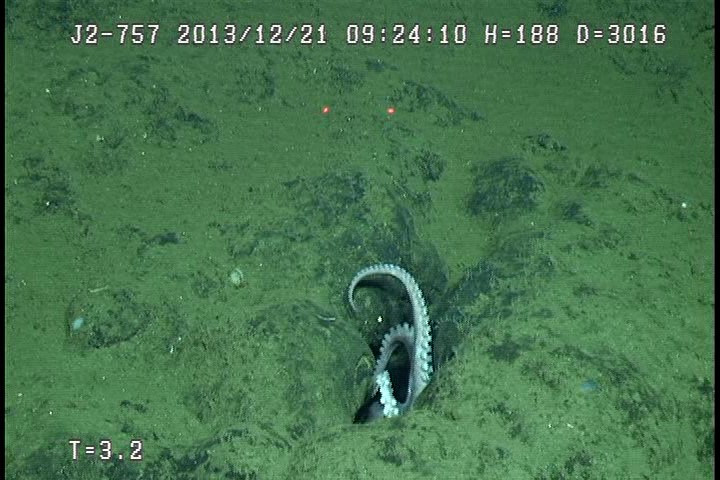- Scientists have discovered a large nursery of octopus mothers some 3 kilometers (1.9 miles) deep in the Pacific Ocean.
- The octopuses are an unknown species of the genus Muusoctopus, a group of deep-sea octopuses generally known to lead solitary lives.
- The octopuses and their eggs will likely not survive, researchers say, because the animals are exposed to warmer temperatures than they are used to.
- But the presence of this large, “suicidal” population of octopuses suggests that there must be many more octopuses living in cooler, more livable crevices on the seafloor, researchers add.
Scientists exploring a patch of the seafloor some 3 kilometers (1.9 miles) deep inside the Pacific Ocean have accidentally stumbled upon a large nursery of octopus mothers.
A team of geochemists had gone looking for warm water seeping out of cracks on the Dorado Outcrop, an expanse of rocky seafloor made of cooled lava from an underwater volcano, located about 250 kilometers (155 miles) west of Costa Rica.
The researchers did find the warm seeps, but they also discovered hundreds of purple octopuses clustered around those seeps, nearly all of them guarding a clutch of eggs. When the researchers returned the next year in 2014, they saw the same thing: octopuses with eggs huddled around a network of cracks on the rocky bottom.
“The focus of [our] expeditions to Dorado Outcrop was to study a cool hydrothermal system. In doing so, we discovered this fascinating congregation of brooding octopuses,” Geoffrey Wheat of the University of Alaska Fairbanks, said in a statement. “To maximize the scientific return of the expeditions, we shared the video with deep-sea biologists, whose research led to this publication.”
Footage of this unusual octopus assembly surprised Janet Voight, associate curator of zoology at the Field Museum in Chicago, U.S.
“When I first saw the photos, I was like ‘No, they shouldn’t be there! Not that deep and not that many of them,’” Voight said. “To my knowledge there had been no reports of octopuses at this or comparable depths off between southern California and Peru.”

Voight and her colleagues identified the octopuses as an unknown species of the genus Muusoctopus, a group of deep-sea octopuses generally known to lead solitary lives. Deep-sea octopuses are also known to live in cold waters, rich in oxygen. But near the warm seeps, the octopuses were exposed to temperatures higher than they were used to.
The warm water poses a problem for the octopuses, Voight and her colleagues write in a new study published in Deep Sea Research Part I. The warmer temperature increases the metabolic rate of octopuses, which makes them need more oxygen than the warm water can provide. In such a hostile environment, the octopuses are likely to meet a tragic end, the researchers say.
None of the 186 octopus eggs that the researchers closely observed showed any evidence of a developing embryo, for example, and the octopuses themselves showed signs of severe stress.
“As the embryos start to develop from fertilized cells, they’re increasing their oxygen use … and they’re confronted with less oxygen available,” Voight told Discover magazine. “I don’t see how they can possibly survive.”
But it’s not all bleak. Octopus mothers breed just once, and spend the rest of their lives protecting their clutch of eggs until they hatch. Voight thinks that the presence of this large, “suicidal” population of octopus suggests that there must be many other octopuses living in cooler, more livable crevices and fissures on the seafloor that “replace the dying mothers and eggs that we can see.”
Voight added that the scientists had sometimes observed octopus arms peeking out from the cracks in the rock, pointing toward signs of an unseen population.
“Never would I have anticipated such a dense cluster of these animals at 3,000 meters depth, and we argue that the numbers of octopuses we see are simply the surplus population,” Voight said.
Wheat added: “This is only the third hydrothermal system of its type that has been sampled, yet millions of similar environments exist in the deep sea. What other remarkable discoveries are waiting for us?”


Citation:
- Hartwell, A.M., Voight, J.R. and Wheat, C.G. (2018) Clusters of deep-sea egg-brooding octopods associated with warm fluid discharge: An ill-fated fragment of a larger, discrete population? Deep Sea Research Part I: Oceanographic Research Papers.